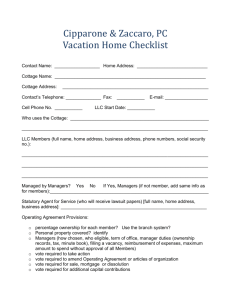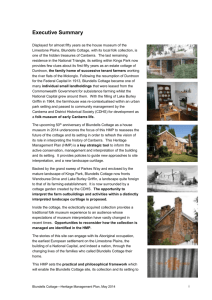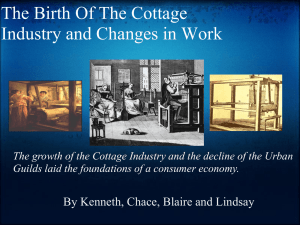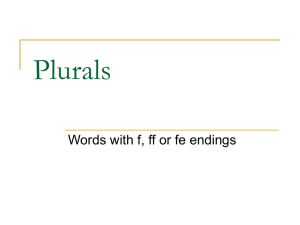08. Blundells Cottage HMP - Outline
advertisement
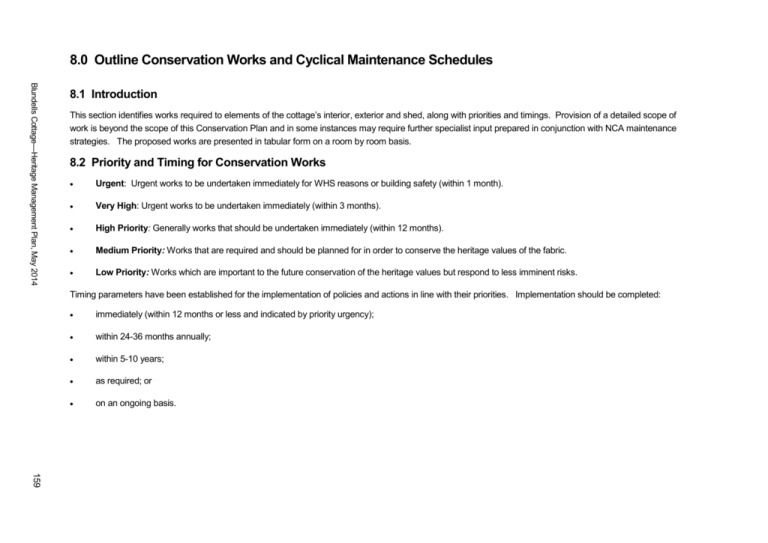
8.0 Outline Conservation Works and Cyclical Maintenance Schedules Blundells Cottage—Heritage Management Plan, May 2014 8.1 Introduction This section identifies works required to elements of the cottage’s interior, exterior and shed, along with priorities and timings. Provision of a detailed scope of work is beyond the scope of this Conservation Plan and in some instances may require further specialist input prepared in conjunction with NCA maintenance strategies. The proposed works are presented in tabular form on a room by room basis. 8.2 Priority and Timing for Conservation Works Urgent: Urgent works to be undertaken immediately for WHS reasons or building safety (within 1 month). Very High: Urgent works to be undertaken immediately (within 3 months). High Priority: Generally works that should be undertaken immediately (within 12 months). Medium Priority: Works that are required and should be planned for in order to conserve the heritage values of the fabric. Low Priority: Works which are important to the future conservation of the heritage values but respond to less imminent risks. Timing parameters have been established for the implementation of policies and actions in line with their priorities. Implementation should be completed: immediately (within 12 months or less and indicated by priority urgency); within 24-36 months annually; within 5-10 years; as required; or on an ongoing basis. 159 160 8.3 Schedule of Works for Blundells Cottage Table 8.1 Identified issues and recommended works for the different components or elements of Blundells Cottage. Element Condition Identified Issue/s Recommended Works Priority Timing Fair The cover strip is starting to come loose. This could become a trip hazard or worse if it catches on someone’s shoe. Carefully re-secure the metal strip to the floor following existing evidence. High 2013 Fair Paint is flaking off the wall. The porch walls are important as the only walls not covered in post-1965 limewash. Seek professional advice on how to stabilise flaking paint and retain the porch wall as it is to indicate the range of colour finishes used during the life of the cottage and use this for interpretation. Refer to Gillian Mitchell Blundells Cottage Paint Analysis 2012 (and Appendix D) for conservation and protection of painted finishes. Medium 2013 COTTAGE INTERIOR Back porch Cover strip between steps and floor Back porch Upper west wall paint Image Blundells Cottage—Heritage Management Plan, May 2014 Blundells Cottage—Heritage Management Plan, May 2014 Element Condition Identified Issue/s Recommended Works Priority Timing Back porch Poor Intercom If the Intercom system is redundant it should be removed. Removal should occur before wall is stabilised. 2013 Upper wall Roof leaks Ceiling stains Loose paint and plaster Back porch East wall Stained Evidence of former water entry. The stains mask whether there is on-going water entry. Gutters and valley on roof may be clogged. Check if leaks have been repaired; monitor for leaks during rain. Research appropriate distemper/limewash products both in terms of content and colour, prepare and apply new. Consolidate if possible, otherwise repair/replace damaged render as it is part of occupancy phase and therefore significant. Check gutters and valley on roof to prevent water penetration. Clean, and /or repaint. 2013 High It will identify if roof still leaking – High. 2013 2015 Medium Medium 2013 2015 Image 161 162 Element Condition Identified Issue/s Recommended Works Priority Timing Room 1 Good Hairline cracks are evident on the west wall and above the window in the eastern wall. No immediate works at this stage as the walls appear relatively stable. The cracks should be monitored for movement, shrinkage and cracks, possibly through the attachment of ‘Telltales’. This could reinforce use of Blundells as a conservation teaching site. Medium 2013 West wall Buy ‘Telltales’ and use in accordance with the instructions. Try <www.hmagroup.com.au>. Blundells Cottage—Heritage Management Plan, May 2014 Room 2 Stove top Poor Decayed mortar by window sill Prior to the room being lime washed the crack should cleared to remove loose material to the substrate and then filled with lime mortar to patch. High 2013 Water is entering through the chimney and rusting the stove top plate. Cap the flue within the chimney opening at top of the chimney but allow vent to permit ventilation. Also check that recently introduced flashing at the junction of the roof and chimney is not causing problems. High Early 2013 Note that recent cuts in Image Element Condition Identified Issue/s Recommended Works Blundells Cottage—Heritage Management Plan, May 2014 Priority Timing High Mid 2013 Very high Early 2013 brickwork to fit flashing are not consistent with sound Burra Charter practice. Contractors may need to be instructed in relation to traditional practices. Room 2 Poor West wall Render is actively spalling in a localised area to the lower right of the stove. This may be on-going, or exacerbated by the water falling on the stove. Salt activity may be involved. Ensure there is no cement under the present surface and remove if necessary. Removed decayed material, apply poultice, dry wall and apply new lime based render once possible salt action has been stabilised. Monitor and check for other damp sources. Room 2 West wall Rising damp Poor An arc of rising damp is evident up to about 700 mm to the left of the stove. The origin of the moisture needs to be located and resolved. Check there is no cement under the current surface and remove if necessary. Remove built up soil and plants from the exterior to be consistent with local external ground level and well below the 50mm plinth. Review the recent flashing around the chimney and rectify. Ensure that roof and ground water is drained well clear of the wall. Make good interior render only after damp problems have been resolved. Image 163 164 Element Condition Identified Issue/s Recommended Works Priority Timing Room 2 Very poor Damp is penetrating the wall from the ceiling all the way down to the floor. There is a roof valley that directs water to this location. The roof gutter also flows to this point. However the down pipe is completely clogged and causing water to run down the wall during rain. Critical Immediate High 2013 High 2013 West wall Falling and penetrating damp Blundells Cottage—Heritage Management Plan, May 2014 Roof water needs to be discharged well clear of the building and a comprehensive review of roof drainage should be undertaken to ensure that all roof water is collected and evacuated. In the short term the down pipe needs to be flushed clear or replaced. Gutters also need to be cleaned on a monthly basis. The internal surface can be repaired only after the external damp has been controlled. Room 2 Poor West window Room 2 Linoleum floor Fair Paint on the interior of the windows is breaking down. Timbers in the sash will start to decay if this is not repaired. The problem is exacerbated by condensation on the inside of glass in winter. Sand back to sound wood, prime and paint. The linoleum is distorting due to the uneven buttjointed subfloor. This will exacerbate decay of the lino. The lino was added by the CDHS in 1963 and renewed in 1970. It is not individually significant but the use of recycled lino by the CDHS is typical of their conservation Reinforce the underside of the lino. If the linoleum is lifted, investigate options for achieving a more level subfloor. Careful preparation will be needed to ensure linoleum is not damaged during lifting. Use antifungal additive in paint or primer. De-humidify the room in winter to actively remove condensation. Image Element Condition Identified Issue/s Recommended Works Priority Timing Blundells Cottage—Heritage Management Plan, May 2014 approach and should be noted and followed (if possible) if the lino is to be replaced. Room 2 Poor There appear to be substantial holes in the roof over this ceiling space and possible gaps where roof sheets overlap. Closely inspect and seal or patch all holes. Increase sheet overlap if re-roofing is found to be necessary. Very high 2013 Fair The hairline crack is immediately below a point on which the door head beam rests, although as the beam carries no weight, it is difficult to see what caused the crack. One possibility is that the beam was used as a scaffold support during previous work. Monitor this crack to ensure that the corner of brickwork does not break away completely. Apply limewash to fill the crack and note if it reappears—which would suggest the crack is growing, in which case structural pinning may be necessary. Do not apply heavy weights to the beam (eg scaffolding), or allow children to swing on it. Medium 2015 Roof over ceiling space Room 3 Hairline crack east wall Image 165 166 Element Condition Identified Issue/s Recommended Works Priority Timing Room 3 Fair A crack extends from the former window sill to the floor. The crack matches cracks on the other side of the wall and indicates some settling in the building or a stress crack from overloading. It is not weakening the structure and appears benign. Rake the crack to firm the substrate and fill it with lime mortar and repaint with lime wash. Low 2015 Poor The base of the bed leg has a sharp point protruding where a castor may have once been located. The point is scratching into the brickwork and causing erosion. Fix a small but broad pad to the base of the cot leg. High Urgent South wall crack Room 3 Blundells Cottage—Heritage Management Plan, May 2014 Brickwork by door Image Blundells Cottage—Heritage Management Plan, May 2014 Element Condition Identified Issue/s Recommended Works Priority Timing Room 3 Slowly deteriorating The mortar capping over this part of the floor is drummy and slowly deteriorating. The mortar is important because it contains several layers of surface treatment. Monitor the mortar and consider consolidation, possibly by injecting adhesive between the layers although this risks exfoliation. Seek further advice from a materials /conservation specialist. Medium 2014 Poor The door knob has worn a large hole in the render from impact when the door is opened. The age of the wear is not established, but it is bad for both the knob and the wall. Fill the hole with render and patch and paint. A small door stop at floor level is needed to prevent the problem reoccurring. Medium 2014 Floor by door Room 3 Door knob impact on wall Image 167 168 Element Condition Identified Issue/s Recommended Works Priority Timing Room 3 Poor This is a continuation of the damp that is causing problems on the NW corner of Room 2. The problem is due to clogged gutters and downpipes externally, plus some deterioration of external mortar. Check and clear/repair the roof and down pipe as necessary. Very high 2013 Urgent Immediate Southwest corner damp Roof water needs to be discharged well clear of the building and a comprehensive review of roof drainage should be undertaken. In the short term the down pipe needs to be flushed clear or replaced. Gutters also need to be cleaned on a monthly basis. The internal surface can be repaired only after the external damp has been controlled. Check ground drainage is directed away from building. Blundells Cottage—Heritage Management Plan, May 2014 Renew mortar with lime based mortar after clearing out all loose material. Allow to dry, scrape off stained material. Apply algaecide if moulds or algae present. Apply new limewash/distemper after researching suitable products. Room 4 No obvious issues Interior Room 4 Ceiling space Stable Presence of asbestos cement sheeting and evidence of former lath and plaster ceiling. The stability of the asbestos cement sheet should be confirmed— the material around the manhole could easily be friable and therefore a risk. There is clear evidence of a Investigate the presence of asbestos by Hazardous Material in Buildings Review and undertake stabilisation. Subject to the recommendations of the Hazardous Material In Buildings Review, it is recommended that within a few years the asbestos sheet Image Element Condition Blundells Cottage—Heritage Management Plan, May 2014 Identified Issue/s Recommended Works former lath and plaster ceiling which could be reinstated or replaced with lath and plaster or fibrous plaster sheet. The lining boards are post-1963 and not significant to this site. be removed and replaced with fibre cement sheet. The introduced lining boards can be reinstated. The fibre cement sheet will keep dust out of the room and the boards represent CDHS input. They will also provide a degree of texture that would have been present with a lath and plaster ceiling, but is lacking in modern plasterboard sheets. Priority Timing Room 4 Ceiling space Dangerous A large amount of debris has built up on the west wall in the ceiling, most probably due to former starlings or rats. The matter is highly flammable. It may also include asbestos. Investigation of asbestos presence and remediation. Engage a specialist to investigate for asbestos presence and recommend appropriate clearing. Urgent Immediate Room 4 Ceiling space Unclear Possible termite activity Inspect regularly and treat if active. Urgent Immediate Install termite baits. Get an assessment for any carpentry repairs or strengthening. Image 169 170 Element Condition Identified Issue/s Recommended Works Priority Timing Room 5 Scuff marks Heavy visitor use has resulted in a fair amount of scuffing along this wall. At an appropriate time the wall could be cleaned and possibly re-limewashed/distempered in accordance with the interpretative presentation of the cottage. Low When other walls are being limewashed/ distempered Room 5 Fair Fretting bricks Investigate to determine the cause—damp or drying? Medium At the same time as similar repairs elsewhere in the building Very high Check for leaking in the flashing in 2013. Remaining works when convenient. Apply a poultice to extract salts and then apply a sacrificial lime mortar, after salts have been removed/stabilised limewash can be applied. Monitor. Blundells Cottage—Heritage Management Plan, May 2014 Room 5 Stains above chimney Fair Stains above the chimney suggest that there has been leaking at the chimney roof junction. It is not obvious if this is old or recent. Check the roof flashing above the chimney and rectify if necessary to prevent further water entry. Clean stains in the short term, and apply limewash/distemper when the rest of the room is being limewashed, in accordance with ‘Blundells Cottage Paint Analysis 2012’ and consistent with the interpretative presentation of the cottage. Image Blundells Cottage—Heritage Management Plan, May 2014 Element Condition Identified Issue/s Recommended Works Priority Timing Room 5 Poor Damp is entering the wall and is evident from floor level through to mid wall height. The source of damp is not entirely clear and it is likely that a range of measures will be necessary. Clear any soil build-up against the outside of the wall. Ensure south wall gutters and drains are effective and that water from leaking water tank is not causing problems. High 2013 South wall Repoint eroded sections of external wall to assist it to shed water. Apply poultice to interior wall, allow wall to dry then apply fresh limewash in accordance with ‘Blundells Cottage Paint Analysis 2012’ and consistent with the interpretative presentation of the cottage. Room 5 Historic fabric The surviving finishes of timber, paint and linoleum are at risk of being eroded from foot traffic. If possible, compare with colour images from Freeman CMP 1994 to determine rate of erosion. Investigate options for consolidation or application of protective film. If warranted, cover with small carpet. Consult specialist materials conservator. Medium 2015 Fair Some of the flooring boards by the front door are loose. These boards may provide access to the subfloor. Screw the boards to the floor using slot head screws. Ensure boards can be easily removed for subfloor inspection. Low 2015 Threshold to room 3 Room 6 Loose boards by front door Image 171 172 Element Condition Identified Issue/s Recommended Works Priority Timing Room 6 Eroding Every time the door is opened or closed, the doorbell swings up and hits the underside of the head beam. This is damaging the paint and substrate. Replace the doorbell with a fixed bell that does not swing. High 2013 Good A small sample of original wall paper has been left exposed. Ensure the sample is not inadvertently damaged. Investigate protection with something like a Perspex cover. Consult specialist materials conservator for conservation options which allow interpretation. Low 2015 Monitor the fireplace during rain to observe if water is entering the chimney. Check chimney flashing and repair/replace as needed. High 2013 High 2013 Door bell Room 6 Original wall paper This is significant fabric that provides an opportunity for reinterpreting the room’s décor. Blundells Cottage—Heritage Management Plan, May 2014 Room 6 Fair Fireplace There are stains in the back of the fireplace which themselves are not a problem, however they may indicate occasional leaking down the chimney. Re-apply limewash. Evidence suggests the fireplace was previously limewashed. Room 6 Fretting brick in fireplace Poor The brick is decaying, probably due to salts, low brick firing and water penetration. Investigate and remove the source of the water. Apply poultice to remove salts and when stable re-limewash. Image Blundells Cottage—Heritage Management Plan, May 2014 Element Condition Identified Issue/s Recommended Works Priority Timing Room 6 Ceiling space Stable There is clear evidence of a former ceiling and shingle roof. Consider additional interpretation of this space to visitors. Low 2015 Urgent Immediate Consider lighting to assist viewing. Room 6 Ceiling space Unclear There appears to be mud tunnel on the edge of a ceiling joist that is consistent with termite activity. Confirm if this is a termite tunnel and treat it. Install termite bait and monitor. Assess and repair any timberwork damage. Image 173 174 Table 8.2 Identified issues and recommended works for the different components or elements of Blundells Cottage main cottage building. Element Condition Identified Issue/s Recommended Works Priority Timing Peeling paint on sash and casement. Prepare carefully and repaint. Medium 2014 Medium 2014 COTTAGE EXTERIOR East wall Fair Window Ensure painting will not result in sticking window or prevent window from opening. Paint colours to be in accordance with ‘Blundells Cottage Paint Analysis 2012’ and consistent with the interpretative presentation of the cottage. Blundells Cottage—Heritage Management Plan, May 2014 East wall Window arch Cracked Subsidence cracks in stone and mortar. Similar cracks are evident elsewhere in the wall and could also be treated. Check lintel is safe. Engage a heritage engineer or experienced heritage bricklayer to provide detailed assessment and long-term strategy for this problem. It may be appropriate to lift the arch and retrofit an arch bar to support the brickwork prior to repointing. Image Blundells Cottage—Heritage Management Plan, May 2014 Element Condition Identified Issue/s Recommended Works Priority Timing East wall Fair Soil is building up in the garden bed. All soil levels next to the building should be kept low and below internal floor level to prevent water entering the stonework. Low 2015 Soil build up Ensure all surface ground water flows away from the building. East wall Poor Damp is accumulating in the corner and supporting the growth of algae and mould. Ensure all gutters and drain pipes are working. Remove algae with an appropriate algaecide only once source of damp is identified and rectified. High 2013 Fair The butt jointed floor boards are decaying where they are exposed to the weather. They have been replaced previously and are not considered to be particularly significant. Treat decayed section of floor boards with commercial wood preservative or apply flood application of 0.33 Turpentine: 0.33 linseed oil: 0.33 Terebine. Medium 2014 Damp Porch Threshold Consider paint sealing the outer 100 mm of the boards as a more permanent treatment. Alternatively replace boards with similar durable hardwood. Image 175 176 Element Condition Identified Issue/s Recommended Works Priority Timing Porch Poor The use of silicon here is an unsympathetic material. Remove the silicon and replace if necessary with a more traditional solution, eg a mortar joint with a small timber cover strip. Low 2015 Poor The gutter is clogged, distorted and overflowing onto the wall of the building and ground below promoting growth of algae and moss. Clear the gutter, straighten and ensure all water flows well clear of the building. Check behind valley flashing as well. Monitor regularly. High 2013 Corner South wall Gutter behind tank Image Blundells Cottage—Heritage Management Plan, May 2014 Blundells Cottage—Heritage Management Plan, May 2014 Element Condition Identified Issue/s Recommended Works Priority Timing Window behind tank Fair Paint is peeling. Carefully prepare and repaint window. Medium 2014 High 2013 A down pipe runs in front of the window. Intrusive security bars. Investigate alternatives to the location of the downpipe guttering. Remove security bars and make good. Investigate alternative security of crimsafe mesh as necessary. Wall behind tank Fair Mortar has eroded in places to leave deep holes. This occurs in multiple locations around the building and will be allowing water penetration. Remove any hard cement. Implement lime based mortar repairs to all locations where mortar has eroded. Allow up to 10% of joints for repointing. Carefully maintain existing masonry character. Match colour and style. Prepare samples first and match when dry. An appropriate mix is 1 lime putty: 3 selected sharp sand. A mix of 1 cement: 2 lime: 9 sharp sand may also be used, especially if it enables a more sympathetic colour match to be achieved. Image 177 178 Blundells Cottage—Heritage Management Plan, May 2014 Element Condition Identified Issue/s Recommended Works Priority Timing Water tank Poor The tank is leaking and needs to be replaced as water leaks onto the ground and is also decaying the timber in the tankstand. The tank was installed in the mid-to-late 1990s and is not individually significant. Replace tank with new galvanised iron tank (not colorbond or zincallume). Urgent 2013 East wall Poor Soil and garden bed has built up between the chimneys. Remove soil and re-grade the ground so water drains away from the building. Urgent 2013 Mortar decay. Remove plant material. Very High 2013 Soil and plant material between chimneys East wall Chimney Repoint only open mortar joints. Poor Spalling bricks and eroding mortar. Resolve the damp which is eroding the pointing—remove built up soil from garden bed and do not water plants next to walls. Apply poultice to withdraw salts. Replace eroded bricks with closely matching Image Element Condition Identified Issue/s Recommended Works Priority Timing replacements. Blundells Cottage—Heritage Management Plan, May 2014 Remove loose material and repoint joints, holes with lime mortar. Intercom by front door Poor The intercom is not consistent with Blundells heritage values. Remove the intercom if it is redundant or arrange alternative. Low 2015 Front Verandah post Poor The base of the post has decayed. Scarf in the timber at the base, or replace the whole post. The post dates from 1963 and is not significant fabric. Any replacement should be like for like; that is, 100 x 100 rough sawn hardwood, sanded and then painted in accordance with ‘Blundells Cottage Paint Analysis 2012’ and consistent with the interpretative presentation of the cottage. Seal the base of the post and secure to pavement with a concealed pin. High 2013 North Verandah roof Poor Leaf litter builds up on the roof and in the gutters resulting in blocked downpipes and water penetration to building. Clean this on a regular basis, ideally weekly given the close proximity of the trees. High 2013 Image 179 180 Element Condition Identified Issue/s Recommended Works Priority Timing North Problematic This is a cluster of trees, one of which is growing over and dwarfing the building. The trees drop large quantities of needles onto the roof which accelerates decay of roof iron by holding moisture onto the roof, allowing water to penetrate between overlaps, clogs gutters and downpipes and which in turn is leading to water penetration into the building as water runs down the walls. The leaf litter on the ground is highly flammable. Follow advice in SULE report on trees at the site. Medium 2014 Problematic The yuccas prevent access to the wall for maintenance. They date only from the 1960s and were initially planted as a deterrent to break ins. They have low significance. Remove the yuccas. They prevent maintenance access and are not original to the cottage’s farm phase. High 2013 Poor Mortar loss on the west wall is generally more pronounced that on the other walls, probably due to greater weather exposure and cyclical wetting and drying. Repoint the worst affected areas with lime based mortar to ensure full joints and reduce water penetration to the building. Allow 50% of pointing to be redone with 1 lime putty: 3 sharp selected sand. Match dry samples for colour and style before repointing affected areas. High 2014–2024 Trees West wall Yuccas Blundells Cottage—Heritage Management Plan, May 2014 West wall Mortar loss Trees at heritage sites have to be managed so that they do not damage buildings. Trees can be replanted to reinstate former landscapes. Image Blundells Cottage—Heritage Management Plan, May 2014 Element Condition Identified Issue/s Recommended Works Priority Timing West wall Poor The existing paint is breaking down. Carefully prepare and repaint both windows in accordance with ‘Blundells Cottage Paint Analysis 2012’ and consistent with the interpretative presentation of the cottage. High 2013 Poor The gutter is clogged and drains to the area where water penetrates into the building. It appears to be directing water onto the wall. Replace the existing gutter and downpipe with a larger galvanised gutter and larger diameter galvanised downpipe. Hand make brackets and install so that gutter collects all water from the roof and valley. Clean the gutter and downpipe regularly (weekly if possible but at least monthly for the first year) and install gutter guards if leaf build up continues to be an issue. Seek SULE and arborist advice for pruning nearby tree branches that contribute to leaf litter on roof. Urgent 2013 Clogged Water can’t get down the downpipe and so spills over the wall. In the immediate instance clear the downpipe. Then replace with larger diameter (75mm) gal downpipe as per the above note. Very high Immediate Windows x 2 West wall Gutter West wall Downpipe The downpipe needs to be larger and able to discharge more successfully at ground level. 181 Install underground stormwater in preference to perforated agricultural drainage. Plastic pipe above ground to be covered with stone and not be visible. Image 182 Element Condition Identified Issue/s Recommended Works Priority Timing West wall New This has been done poorly and not consistently with traditional methods. The flashing has been cut into the brickwork instead of stepped into the mortar course. The cross flashing appears to direct water under the roof iron. Flashing should be removed and replaced by a tradesman who is appropriately trained. In future, such work should be only undertaken by people with appropriate expertise. Urgent 2013 Chimney flashing It is not known if this work has led to the leaking onto the stove below. Image Blundells Cottage—Heritage Management Plan, May 2014 Table 8.3 Identified issues and recommended works for the different components or elements of Blundells Cottage slab shed building. Element Blundells Cottage—Heritage Management Plan, May 2014 Condition Identified Issue/s Recommended Works Priority Timing Loose The gutter has drifted away from the roof and is not functional. Reinstate and monitor effective operation. High 2013 Good Do not seal the building completely. Investigate if clay caulking was originally used. Only replace galvanised cover strips if there is conclusive evidence of prior clay sealing of the slabs and exact nature of clay caulking used. Do not proceed on the basis of past general custom or conjecture. As necessary As necessary SLAB SHED Slab shed Gutter Slab shed Galvanised cover strips Fabric introduced by CDHS. Image 183 184 Element Condition Identified Issue/s Recommended Works Priority Slab shed Poor Peeling paint Prepare carefully and apply new paint or umber stain to the door in accordance with ‘Blundells Cottage Paint Analysis 2012’ and consistent with the interpretative presentation of the cottage. Medium 2014 Good The top plate provides evidence that this shed is the one that has been on the site from early days. Retain all evidence embedded in the shed’s fabric such as this rebate that supported the buggy lean-to roof. High Ongoing South door Slab shed East wall Blundells Cottage—Heritage Management Plan, May 2014 Top plate Timing Image Blundells Cottage—Heritage Management Plan, May 2014 Element Condition Identified Issue/s Recommended Works Priority Slab shed Fair Gutter does not seem to be aligned. Keep the gutter and ground clean and ensure water is draining away from building. A full plumber assessment is recommended. Medium 2013 Leaf litter must be regularly removed from building up against and near to the building as it will again lead to decay of base plates and slabs High 2013 East wall There is leaf litter at ground level. Slab shed West wall ground conditions Poor Leaf litter is building up at ground level. A tree management strategy is recommended. Timing Image 185 186 Element Condition Identified Issue/s Recommended Works Priority Slab shed Poor Gutters fill with leaf litter from the nearby trees. Clean gutters regularly, at least on a monthly basis. High Immediate Poor There is leaf litter between the tank and the slab wall that is likely to lead to decay of timbers. Clean the leaf litter out. High 2013 West wall gutter Slab shed Blundells Cottage—Heritage Management Plan, May 2014 West wall Move the tank away from wall a sufficient distance to allow regular access for cleaning. Timing Image Blundells Cottage—Heritage Management Plan, May 2014 Element Condition Identified Issue/s Recommended Works Priority Slab shed Poor There is peeling paint and timbers are starting to decay. Check the security of hinges and their hanging. Fix as necessary. Carefully prepare and repaint to match existing colour scheme in accordance with ‘Blundells Cottage Paint Analysis 2012’ and consistent with the interpretative presentation of the cottage. High 2013 Mixed Ensure that rain water doesn’t enter the building. Monitor and re-grade the bricks if required. The bricks are modern introductions to the landscaping and can be altered. Low Ongoing Shed door Slab shed Doorway Timing Image 187 188 Element Condition Identified Issue/s Recommended Works Priority Slab shed Modern The use of bright chrome, stainless steel and Phillipshead screws are not suited to the historic presentation of Blundells cottage. Replace with more appropriate functional hardware—a blacksmith may be necessary for manufacture. Low 2015 Bright zinc finish These bright steel screws won’t patinate over time. Ideally galvanised screws will be used. Obtain a supply of galvanised screws and lead washers for future repairs. Low 2015 Door catch Slab shed New roofing screws throughout Timing Image Blundells Cottage—Heritage Management Plan, May 2014 8.4 Cyclical Maintenance Timing Guidelines for Blundells Cottage Blundells Cottage—Heritage Management Plan, May 2014 Table 8.4 Maintenance Guidelines for Blundells Cottage. Regularity Building Element Tasks Roof Clean gutters valleys downpipes and skillion roof of leaves and pine needles. Check for loose screws and lifting sheets and tighten as necessary. X Check roof iron to determine if there is advanced rusting likely to cause leaking. X Check all lead flashings etc to ensure they have not lifted or failed. X Remove built-up leaf and soil debris from around the base of the slab shed such that the timber slabs are not covered. Undertake termite inspection. Check exposed timbers on porch and verandah for decay and apply wood preservative as required. Timber work As Necessary 6 monthly Annually Monthly X X X Every 2 yrs Every 5–10 yrs 189 190 Regularity Building Element Building fabric Blundells Cottage—Heritage Management Plan, May 2014 Electrical services Tasks As Necessary 6 monthly Annually Every 2 yrs Check internal timber floors for wear and tear etc and take remedial action as required. X External paintwork—inspect and repaint if necessary. X Check external mortar in stone work and repoint if excessively decayed. X Check external mortar and brickwork to chimneys and bread oven and restore if decay is excessive or rapid. X Check internal fireplaces for decay and apply limewash as a sacrificial mortar. X Undertake asbestos condition inspections so long as asbestos material remains on site. X Check for efficacy as required and that earth and circuit breakers are functioning. X Ensure wires have not been damaged by rodents etc, and that there has not been a build-up of flammable material, water etc near power points, junction boxes meter boards and the like to ensure minimal likelihood of fire due to electrical fault. Inspection must include the roof space. Every 5–10 yrs Regularity Blundells Cottage—Heritage Management Plan, May 2014 Building Element Tasks Cleaning Clean all walls, floors etc Landscape Ensure vegetation is not growing into or causing decay of building fabric. Ensure that soil levels have not built-up against walls such that they are promoting rising or penetrating damp in the building. Check levels and falls to ensure that storm water can drain freely away from the building. Mow grass and undertake garden management (pruning, weeding etc) As Necessary 6 monthly Annually X X X Every 2 yrs Every 5–10 yrs 191
